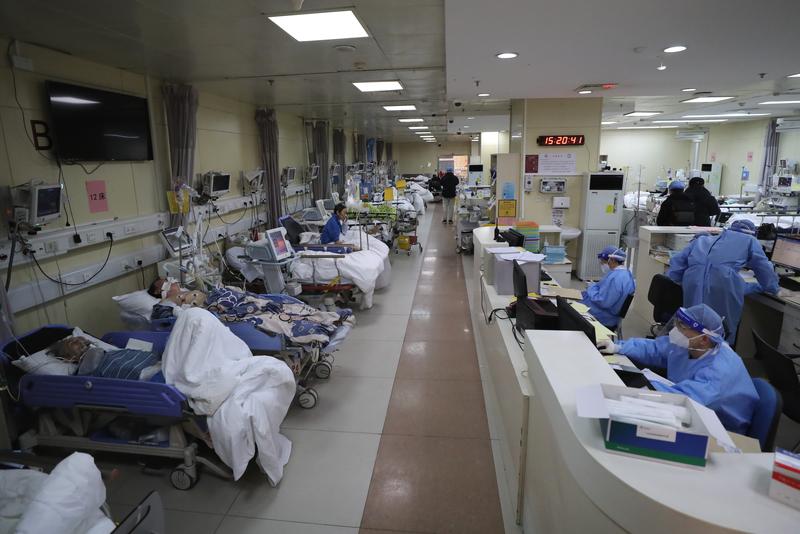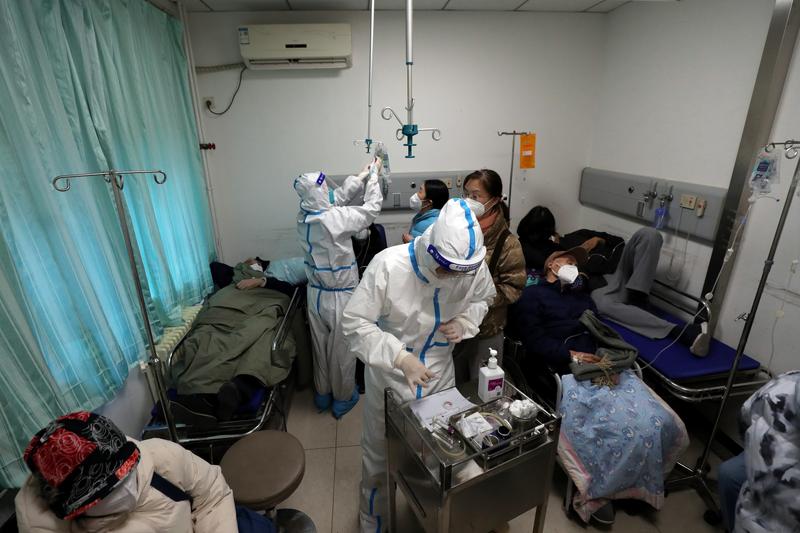Newly formed treatment systems have taken the lead in dealing with the disease. Du Juan reports.
 Patients receive treatment at the emergency clinic of the Beijing Chaoyang Hospital on Dec 27. (WANG ZHUANGFEI / CHINA DAILY)
Patients receive treatment at the emergency clinic of the Beijing Chaoyang Hospital on Dec 27. (WANG ZHUANGFEI / CHINA DAILY)
After Beijing optimized its COVID-19 control measures early last month, authorities established a comprehensive medical treatment network and made full use of grassroots facilities to cope with the soaring number of cases.
"Thanks to the effective treatment networks, Beijing has passed its infection peak," said Yin Yong, Beijing's acting mayor, in an interview with China Media Group on Jan 9, about a month after the city lifted its strict control and prevention regulations.
Beijing has eased the medical pressure by expanding the number of fever clinics, optimizing emergency transfer and admission channels, enhancing cooperation between different levels of hospitals.
Li Ang, spokesman for the Beijing Health Commission
Now, most residents have been infected with and recovered from the disease. Hospitals have played a critical role, while the city government, especially the health bureau, has introduced measures to combat the virus and save lives.
"Beijing has eased the medical pressure by expanding the number of fever clinics, optimizing emergency transfer and admission channels, enhancing cooperation between different levels of hospitals and redoubling efforts in the treatment of critical illness," said Li Ang, spokesman for the Beijing Health Commission, at a news conference on Jan 6.
After the control measures started being lifted on Dec 8, authorities ordered all community health centers to establish fever clinics so they could accommodate more patients.
The centers, whose major task used to be identifying positive cases, are now working to meet the medical needs of residents, especially providing services to key groups, such as seniors and people with underlying illnesses to help prevent them from developing into critical cases.
The growing number of patients saw health centers facing difficulties in terms of a shortage of staff members and a lack of medicines.
However, the situation improved after all the medication manufacturing plants in the city began working at full capacity. Nearby provinces also helped by delivering medicines to the capital.
By Dec 19, the number of fever clinics in Beijing had risen to 1,263 — 960 of them in communities — from the 94 that existed before the control measures were lifted, the commission said.
Cui Xueli, director of a health center in the Sanlitun area of Chaoyang district, said the number of residents visiting the center has fallen to a relatively normal level in the two weeks since the peak outbreak because people now understand that they don't need to visit if their symptoms are mild.
As a result, health centers can devote more time and energy to helping patients with urgent and serious needs.
Maximize services
On Dec 12, a few days after the city lifted the strictest control measures, Li told a news conference that authorities were working to improve the grade-based diagnosis and medical services network.
To help a greater number of people, Beijing promoted such services by establishing 56 treatment networks, with three levels of facilities.
In each network, a top-level hospital acts as a lead, followed by several second-level hospitals and grassroots health centers or hospitals, according to the health commission.
A complete diagnosis and transfer mechanism has been built in each network to treat different types of patients. If grassroots hospitals receive critically ill patients they are unable to treat, the top-level hospital in the same network will provide a green channel to accept them.
When the patient's condition stabilizes after treatment at the top-level hospital, they will be transferred back to grassroots facilities for further rehabilitative treatment, including transfusion and oxygen therapy.
 Medical workers attend to patients at the fever clinic of the China-Japan Friendship Hospital in Beijing on Dec 27. (WANG JING / CHINA DAILY)
Medical workers attend to patients at the fever clinic of the China-Japan Friendship Hospital in Beijing on Dec 27. (WANG JING / CHINA DAILY)
The measures significantly eased staff member shortages and the pressures resulting from soaring patient numbers at the top-level hospitals during the infection peak.
In addition to the grade-based diagnosis and medical service network, Beijing introduced other measures, including health monitoring for key groups, classified management (of patients) and online medical services, according to Li.
The city government ordered hospitals to stockpile medicines and medical equipment, increased the capacity of intensive care units and expanded the number of intensive care specialists through training. It also offered help to facilities that required assistance.
Health commissions in all districts conducted surveys of seniors with existing illnesses and introduced grade-based health management to prevent any treatment delays.
Community health centers distributed pulse oximeters to seniors and other high-risk groups so they could measure their own oxygen levels.
Advice, assistance
Patients with mild symptoms or asymptomatic carriers are being advised to stay home to recover. If their health worsens, they can visit nearby community health centers.
People with serious symptoms and those with existing health conditions must be transferred to higher-level hospitals.
Meanwhile, Beijing has taken full advantage of online diagnosis and other information technology. Statistics from the health commission show that by last month, 44 internet hospitals and 167 regular facilities were offering online diagnoses.
The health commission has stated that public hospitals should offer online medical treatment at the same cost as on-site services, with the outlay covered by the medical insurance system.
Medication can be delivered to patients by third-party units after approval by a pharmacist.
The commission has also issued guidelines on home recovery and community health management, and provided manuals about rehabilitation at home.
The information was released in a timely fashion to serve people's needs during the outbreak's peak.
All districts have released contact details for family doctors and identified the areas they oversee so people with a fever or cough can have consultations with medical professionals, who will offer advice according to the person's symptoms.
Seniors with mobility problems are being offered a door-to-door diagnosis service or assistance in transferring to higher-level hospitals, based on health evaluations by medical advisers.
The measures are providing ample cover for the city's residents.
For example, early this month, an 83-year-old woman surnamed Zhang was treated for COVID-19 at a community hospital in Chaoyang.
The medical network ensured that she received rapid treatment after doctors held an online meeting with experts at the China-Japan Friendship Hospital — the top-level facility in their network — to discuss her condition. After several days of treatment, Zhang's health improved.
Experts also visited the community hospital to provide diagnostic advice.
Bai Yongtao, director of the community hospital, said the network with different grade-based hospitals has made it possible to use the major facilities' resources to serve more people effectively.
Wang Songsong contributed to this story.
Contact the writer at dujuan@chinadaily.com.cn


